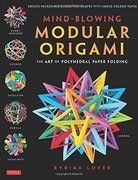
The Alphabet
Extract from Mind-Blowing Modular Origami • By Byriah Loper • Published by Tuttle PublishingAbout
Mind-Blowing Modular Origami
This is the single most time-consuming project in this book; when it was first constructed it was the largest Wire Frame modular ever made. Its polar dihedral symmetry distinguishes it from all other models in this book, as it is not based on a regular polyhedron. The name comes from its connection to planar modulars, where each plane is a assigned a letter of the alphabet. Here, the twenty-six frames represent each of the letters of the alphabet.
This model has only one paper proportion: 1:2.41. If using the template, start with relatively small squares. Rectangles ripped from 3.5" squares make a ~10" model.
-
 Crash Blackburn added The Alphabet to Paper insanity
09 Aug 21:34
Crash Blackburn added The Alphabet to Paper insanity
09 Aug 21:34
-
 Mikayla B. favorited The Alphabet
08 Sep 02:40
Mikayla B. favorited The Alphabet
08 Sep 02:40
-
 Gibran Isaacs favorited The Alphabet
16 Jun 06:13
Gibran Isaacs favorited The Alphabet
16 Jun 06:13
-
 Gibran Isaacs favorited The Alphabet
16 Jun 06:13
Gibran Isaacs favorited The Alphabet
16 Jun 06:13
-
 Kai' K. favorited The Alphabet
13 Jan 23:23
Kai' K. favorited The Alphabet
13 Jan 23:23
-
 jabbathemut added The Alphabet to paper
16 Dec 15:43
jabbathemut added The Alphabet to paper
16 Dec 15:43
-
 Suzi T. favorited The Alphabet
11 Dec 20:54
Suzi T. favorited The Alphabet
11 Dec 20:54
-
 amalia.syamra favorited The Alphabet
01 Dec 08:04
amalia.syamra favorited The Alphabet
01 Dec 08:04
-
 amalia.syamra commented on The Alphabet
01 Dec 08:03
amalia.syamra commented on The Alphabet
01 Dec 08:03
-
 Alissa B. favorited The Alphabet
23 Nov 18:33
Alissa B. favorited The Alphabet
23 Nov 18:33
You Will Need
-
 Step 14
Step 14Unit Preparation
The crimp formed using the given folding method makes a 75-degree interior angle. Such units are used to make stellated polygons. The actual angle for perfectly flat polygonal frames as used here should be roughly 74.4 degrees. Using the formula (360/n+a), where n is the number of sides on the given polygon and a is the interior angle of each vertex, you can find the necessary crimp angle for any star polygon. The 75-degree angle lets the units have a slightly wider dihedral angle than perfectly angled crimps would allow.
Book and cupboard fold; unfold. -
 Step 33
Step 33One complete icosikaipentagonal star, composed of twenty-five units. The name sounds intimidating, but it is simply the geometric name for a twenty-five sided polygon. It is called a star because it is a stellated polygon rather than a regular one, but is not an icosikaipentagram. Thus this model is composed of twenty-six interlocking twenty-five-sided stars.
-
 Step 34
Step 34Weaving Instructions
This model is very different from all others in this book. First, it is critical to recognize that it has polar dihedral symmetry; there will be a large “hole” on the top and bottom of the model. There is no regular polyhedron on which this compound is based; therefore the assembly will rely on axial weaving. -
 Step 35
Step 35Basically, there are twenty-five polygonal “bands” that weave around each other to form the large “holes” on either side of the model. The twenty-sixth frame wraps around the center of the model, and is the only frame that has no interaction with the poles. In the photos below, the twenty-sixth frame is the light-blue band that is fully completed, and the pieces of other frames are parts of the center.
-
 Step 36
Step 36The weaving of this model is actually simpler than you might think, once the pattern is understood. The schematic above shows the center light-blue frame—represented by the light-blue segment—and its equatorial relationship with other frames. There will be ten four-fold axes along each “file” of the model.
-
 Step 38
Step 38Along each “file” of the model, starting at the center twenty-sixth frame, there will be one five-fold axis, followed by ten four-fold axes, followed by one three-fold axis near one of the poles, before the frame bends back down into the model as indicated by the arrow on the photo at the top left of the facing page.
-
 Step 40
Step 40The number of assembled units in each picture is not specified since units can be added randomly, as needed. Also, the nature of the crimped units should make frameholders unnecessary, even in the earlier stages. The below right and top left facing page photos show the first complete pole forming.









































